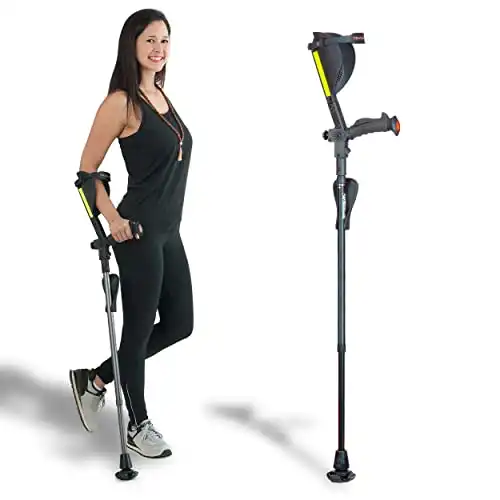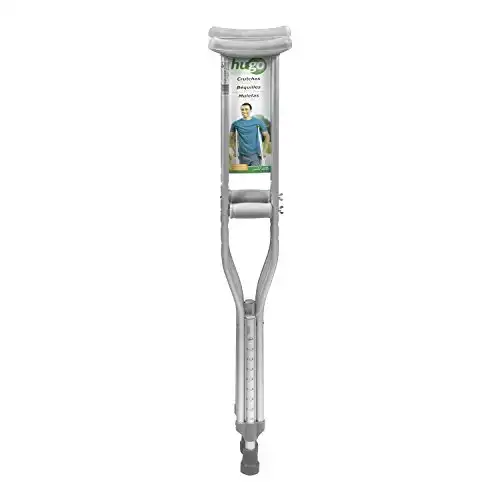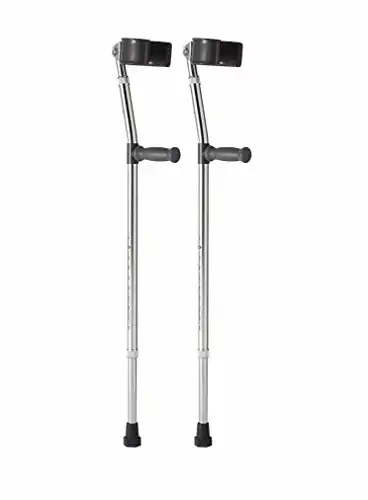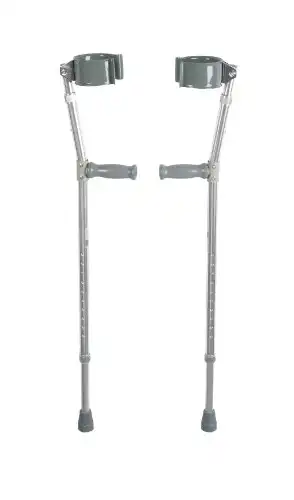According to the US census, about 5% of the American population (about 16.5 million people) uses a cane, crutch or a walker1. A number of reasons may lead one to use crutches. One may have suffered a bone fracture in one of their legs, pulled a hamstring, or sprained an ankle. In a more severe case, an amputated leg or partial paralysis of the lower body may necessitate the use of one or a pair of crutches.
Crutches are most effective when the crutch user needs to take the load off one leg but she or he still has the other leg for (partial or complete) support. They are primarily used for non weight bearing injuries, primarily in the lower leg or the foot.

Non-weight bearing crutches help the user keep weight away their injured leg. This will heal the affected leg faster and help in getting back to full mobility.
The video below shows how to use a non weight bearing crutch.
Crutches are also useful in the case of foot and muscle injuries, the notable ones being Achilles tendon ruptures, foot fractures, stress fractures, and muscle sprains.
In this article, we take a look at some of the best crutches for long-term use. The table below provides a quick snapshot of our top picks, while we go into more details and discussions further down with suggestions on how to find the for you.
|
Type:
Forearm
|
Type:
Underarm (For Tall People)
|
Type:
Underarm
|
Type:
Forearm
|
Type:
Underarm
|
Type:
Bariatric, Forearm
|
|
Height Range:
5' to 6' 6"
|
Height Range:
5’10” to 6’6”
|
Height Range:
5' 2" to 5' 10"
|
Height Range:
5' to 6' 2"
|
Height Range:
4' 11" to 6' 4"
|
Height Range:
5' to 6' 4"
|
|
Product Weight:
2.8 lbs (1 crutch only)
|
Product Weight:
3.8 lbs
|
Product Weight:
3.8 lbs
|
Product Weight:
5 lbs
|
Product Weight:
4.5 lbs
|
Product Weight:
4.86 lbs
|
|
Weight Capacity:
360 lbs
|
Weight Capacity:
250 lbs
|
Weight Capacity:
300 lbs
|
Weight Capacity:
250 lbs
|
Weight Capacity:
250 lbs
|
Weight Capacity:
500 lbs
|
Contents
What Are the Different Types of Crutches?
The kind of crutch that will suit you the best will depend on your body type, fitness level, and your age. Most of us are familiar with the conventional underarm type crutch. However, these days, there are some more options to choose from. We are going to look at the different kinds of crutches available.
Underarm Crutches
Underarm crutches are also known as axillary crutches. These are the most common form of crutches in use. In fact, some people believe that they are the only option available in the market.
Underarm crutches can be used for all injuries of the leg and can assist you in moving around without putting any weight on the injured leg. This gives your injury time to heal.
Usage of underarm crutches, however, restricts the use of your hands and arms. You may need assistance in performing certain daily tasks and chores. Using these crutches can sometimes be painful putting immense pressure on your underarms, wrists, and hands and causing them to become sore. Additionally, they are also become exhausting to use. There is also a chance of experiencing axillary nerve damage if they are not used correctly or used for longer amounts of time.
How to Use: The best way to use these crutches is by standing straight with the underarm crutches slightly in front of the feet and keeping the crutch pad 1-2 inches below your armpits. You need to swing your legs forward between the crutches and ensure that you land on the good leg. This movement is continuously repeated.
Price Range: The underarm crutches fall in the price range of $10 to $50
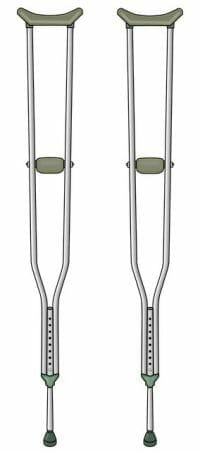
Forearm Crutches
crutches are also known as Lofstrand crutches or elbow crutches. They function much like crutches. The primary difference is that these crutches have an open cuff that is used to grip your arms during usage. If you have the needed strength in your upper body, a or may be your best bet.
crutches transfer your body weight from the to your forearms and upper body. The way they are designed, crutches use more than traditional crutches. However the weight of the body is spread across a much larger area on your arms.
crutches are typically made of an aluminum tube shaft and are often height adjustable. They have a riveted connected with a for locking onto your . crutches use more as compared to crutches, but they give you more control over your movement. They are often used for long-term illnesses and injuries. They are also easier to use on stairs and other forms of uneven terrain.
However, crutches have some potential downsides as well. You cannot use your hands for any other work and this leads to inconvenience. They can make them painful to use, especially on your hands. They can also be tiring to hold, even after a short duration of use.
How to Use: The usage of a or is similar to using an . You would need to use your and crutches to support your movement. Swing your weight forward between the crutches and land on the uninjured . You should ensure that the cuff of the is 1-1.5 inches below your elbow.
Price Range: Forearm crutches cost somewhere in the range of $25 to $150.
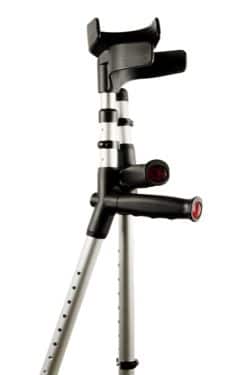
Bariatric Crutches
Bariatric crutches are a perfect solution for folks with a larger build. They are built of steel and can support up to a weight capacity of 550 pounds. They are designed to keep durability and strength in mind. Additionally, the handgrips and the armpit pads have extra thick latex padding that adds to the comfort of the crutch user.
How to Use: Bariatric crutches are used in a similar way as underarm crutches, but they provide more stability for higher weight levels.
Price Range: Bariatric crutches cost somewhere between $20 and $80.
You may also like Is a Knee Scooter Better than Crutches?
Factors to Consider When Buying Crutches
The type of crutch that you choose depends on your requirements. The key factors that you should consider before buying crutches are outlined below.
- Strength Needed: All types of crutches need a certain amount of upper body strength for proper usage. There is a common misconception that while using crutches, the body weight is supported only by the arms. The weight is distributed throughout the entire upper body. In fact, the muscles of the shoulders and trunk do just as much work as the arms. While forearm and underarm crutches need the strength of the upper body while using it, in the case of forearm crutches the requirement of strength is more. If the core strength you have is limited, you might even want to look at an alternate like a knee scooter.
- Balance: The balance of a crutch significantly affects the comfort level with which you can use it. An ergonomically designed and balanced crutch helps to better distribute body weight on your entire upper body including your shoulders and chest muscles. Balance and stability can be improved by making the low-end tip of the crutch wider and being made of a material that encourages friction with all kinds of flooring.
- Material of construction and weight: Crutches bear your weight all day. Conversely, you may need to carry around your crutches all day as well. Therefore, it is really important that the crutches are made of a durable but light metal to withstand human weight, and at the same time be lightweight for ease of use. You should look to buy crutches that weigh less than 5 pounds altogether.
- Fit: Crutches should be properly fitted to their user. You must be able to comfortably stand straight using your crutch, with your elbow bent between 15 and 30 degrees while your hand is resting on the handle of the crutch. You need to ensure that the crutches are the right size for your body. Crutches, if not fitted properly, can often lead to muscle pains, abrasions, and nerve damage. Proper fitting is especially essential for underarm crutches.
- Crutch Tips: Crutch tips are very important since this is the point where they come in contact with the ground. Crutch tips generally have a rubber, slip-resistant tip. Larger tips provide greater stability considering that they have a wider surface area in contact with the ground. Furthermore, some crutches have features like special spring assist technology, which helps the crutch in moving with the user and adapting to their gait. Irrespective of the kind of crutch that you are using, you should ensure that the crutch tip is solid and unbroken.
- Crutch Handles: All crutches tend to place a lot of strain on the wrists and hands. For this purpose, some crutches come with special handles that have extra padding and can reduce stress, making your walking aid easier to grip. Other handles offer ergonomic shaping specific to your left or right hand. This offers greater security and comfort to the user. Always ensure that your crutch has a handle that is comfortable making it easier to use for a long duration.
- Size: Most crutches come with the feature of being height adjustable within a range. To maintain a good posture while walking on crutches, you should be able to adjust it to a height suited to you. To measure your crutch height, stand upright and fully extend your hands beside your body. If you now fold your fingers to form a grip, the crutch grip height should be the distance from your grip to the ground. You should always ensure that this measurement is within the range of adjustable heights of your crutch.
- Adaptability: Learning to walk using crutches can sometimes be a real challenge in terms of adapting your lifestyle to using crutches. Underarm crutches are easier to master at first and are the most common type of crutch. However, forearm crutches have proved to provide a greater amount of control over your movement. In the case of more active patients, forearm crutches are often suggested considering that they allow different gaits for different terrains.
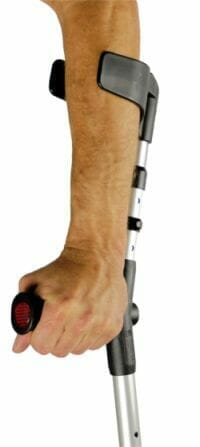
You may also like How to Use One Crutch After Hip Replacement
How to Use Crutches
When learning to use crutches, it is important to remember that crutches require dexterity, balance, upper body strength, and the use of both hands. It will definitely take practice to master your way around crutches.
You should practice in an open. large area with even ground. Your progress can be impeded by obstacles like uneven terrain or navigation in small spaces. Once you have learned how to walk with your crutches, you will never forget how to use them. Here are some tips to get you started as quickly as possible.
Getting Started
As a first step, you need to ensure that your crutches have been adjusted properly according to your height. You should select a pair of shoes during your recovery that you will wear regularly and make the height adjustment for your crutches while wearing them. Wearing differently soled shoes during your recovery would mean that you would need to adjust your crutches again accordingly.
The crutch height should be adjusted so that the top portion of the crutch is positioned under the arm, around 1.5 to 2 inches below your armpit. Do not jam the crutches into your armpits. The body weight should be concentrated on your hands and the handgrips. You should prevent your shoulders from carrying any of the weight as this may lead to shoulder pain.
Once you can adjust the height correctly, you should stand naturally and adjust the handgrips so that there is a 15-degree bend in the elbow.

Using Your Crutches
Stand on your good foot and your injured foot up, place both crutch tips on the ground in front of you, a little more than hip-width apart, and around 12 inches in front of your good foot. The length of the slide depends on the length of your legs. The longer your legs, the longer will be your stride.
Swing your body ahead while gripping the handgrips and leaning on your crutches to get support. Lift your good foot and place it a single step in front of the resting crutch tips. The distance traversed needs to be short enough for you to feel stable, approximately 12 inches. Always ensure that your injured foot stays off the ground at all times. Repeat the process for continuous movement.
You may also like Walker, Crutches, or Cane After Hip Replacement
What Are the Best Crutches for Long-Term Use?
Crutches come in a variety of styles and selecting the right one that will offer you convenience and comfort will depend on your injury type and physical ability. To help make your buying decision a bit easier, we have composed a list of the best crutches for long term use.
Our top choice for crutches in terms of useful features is the Ergobaum 7G Ergonomic Forearm Crutch. It is a feature-loaded crutch (single unit) but is a wee bit expensive. In terms of price, the best priced (and highly rated) pair of crutches on our list of best crutches for long-term use are Hugo Mobility Underarm Aluminum Crutches.
#1 – Ergobaum 7G Ergonomic Forearm Crutch
The New Generation Ergobaum 7G Ergonomic crutch provides you with mobility aid along with enhanced safety, comfort, and performance. The crutch is sold as a single unit and uses medical-grade aluminum.

This crutch was designed by an orthopedic surgeon. It is made to reduce friction and pain with the use of the patented Ergocap High-Performance Tip and a patented shock absorber in the lower portion of the crutch. The Ergobaum crutch also features shock absorbers that take away the impact of your gait when the crutch hits the ground. There are two sets of shock absorbers in the crutch – one in the tip and the other in the handgrips of the crutch.
The handle design of the crutch is unique, cushioned, and strong. This allows for a comfortable grip reducing the amount of stress on your hands.
The crutch is comfortable to use with padding on the handle and on the arm cuff. The arm cuff distance from the handle is also adjustable and the cuff has a padded strap so that the crutch does not fall off when you leave the handle.
The best feature, however, is the knee rest that can be adjusted in height; you will realize this as soon as you are required to wait in a queue for a moderately long time. Once you have adjusted the knee rests to your height, however, the crutches then automatically become left and right-handed, instead of being interchangeable. The crutch also has heavy-duty non-skid tips which are an addition to the safety features. This is a feature-rich device that you can look to purchase if you have a generous budget for a crutch.
The Ergobaum crutch is ideal for users in the height range of 5 feet and 6’6″. It can support a weight capacity of up to 360 pounds. It is foldable and can comfortably fit in compact spaces.
This crutch also features safety light reflectors and LED lights for maneuvering in dark places. Other novel features include a horn (seldom used feature), and the option to adjust handle angle from +15 to -15 degrees.
Do be mindful that all these extra features make this crutch expensive compared to its peers. Users have also complained of it being heavy (2.8 pounds for 1 crutch).
Pros
- Suitable for users with latex allergies as the product is 100% latex-free.
- Adjustability in angle of the handle is really helpful to prevent fatigue from long use
- Reflective light and band on the crutch make it visible in low light
- Convenience of use: The padding on the handle and the arm cuff, along with the cuff strap to keep the crutch in place are features that increase the comfort of using this device
- Reflectors on handle and forearm support make the device more visible in low light
- Shock absorption mechanism on the crutches reduces strain on upper body
- Easy adjustability of crutch height makes the crutch suitable for use by individuals in height ranging from 5 ft to 6.6 ft
Cons
- A bit expensive compared to traditional crutches.
- The feature-rich crutch is significantly heavier than other forearm crutches
- Adjusting the knee rests can take some work and a screwdriver
#2 – DMI Lightweight Underarm Adjustable Crutches
The DMI lightweight Push-Button Adjustable crutches are high-quality crutches that help you in moving more smoothly as you are recovering from injuries or surgery. They include convenient push buttons that allow you to adjust the height of your crutches quite easily and get a comfortable custom fit.

They are made from lightweight anodized aluminum that makes it easier for you to move around. Each pair of these adjustable crutches comes with comfortable crutch pads, handgrips, and durable tips.
These crutches are convenient and easy to carry with easy-to-use push buttons. The height is adjustable from 37 inches to 45 inches (and up to 60 inches, if opted for Tall or Adult model). These crutches are convenient for those within the height range of 4’6″ to 5’2″. You can opt for the Tall or Adult version if you fall within the height range of 5’2″ to 6’6″.
Pros
- Lightweight and easy to carry.
- Height can be easily adjusted through the push of a button.
Cons
- The weight-bearing capacity is only up to 250 pounds and is thus not suitable for people on the heavy side.
#3 – Hugo Mobility Underarm Aluminum Crutches
The Hugo mobility 721-785 Crutches weigh 3.85 pounds and are made from lightweight anodized aluminum. The aluminum build is lighter than wood, it can support up to 300 pounds. They are adjustable crutches and can accommodate an individual’s height in the range of 5’2″ to 5’10”. In case your height does not come within this range, there are options for tall adults and youth that would cater to ranges higher or lower than these. They feature a dual push-button adjustment for adjusting the height.

The contoured crutch tips feature a curved stair deflector at their tip and provide amazing traction while a built-in metal ring protects against any form of premature wear. The product offers superior ergonomic comfort and is also smooth for easier cleaning.
The Hugo crutches have thick cushioned underarm pads and washable hand grips. The handgrips form a natural sponge cushioning that can absorb impact shock and they are perspiration resistant. All these features make it easy for the user to go further without feeling fatigued. They are solid and adjustable walking support indoors or out.
Pros
- Lightweight and easy to carry.
- Washable hand grips are perspiration-resistant.
Cons
- Not suitable for people with a weight greater than 300 pounds.
You may also like Different Walking Assistance Devices for the Elderly
#4 – Medline Forearm Crutches
The forearm crutches from the well-known mobility aid company Medline are made of lightweight but high-strength aluminum with vinyl-coated arm cuffs. The vinyl coating helps to keep the crutches on your forearms by creating friction. Although the circumference of the arm cuff cannot be adjusted, the distance between the handle and the arm cuff can be adjusted to customize as per your arm size.

The crutches come in 3 sizes of Tall Adult (178 – 198 cm), Adult (152 – 188 cm), and Youth (127 – 157 cm), all of which can support a maximum weight capacity of 250 pounds. If you are a bariatric user with more bodyweight than this, you should consider an alternative product.
The crutches are fitted with expanded rubber tips for better traction with glossy floors. If you are anticipating heavy outdoor use with your crutches, you may consider buying extra tips, as you will notice that the tips are the first parts to start to wear out.
The crutch handles are basic and made of solid plastic, which may require you to getting used to them. You may consider wearing padded bikers’ gloves if the handles start hurting your hands in the first few days after long use. These crutches are good for long-term use and constructed for rough use.
Pros
- Easy to adjust for height with telescoping parts and locking nuts
- Non-skid expanded rubber tips provide for more stability and friction
- You can adjust the handle to arm cuff distance to match your forearm length
- Lightweight and comfortable for long use
- Convenient to carry a small bag along by hanging it on one of the open crutch handles
- Good value for money
Cons
- Outdoor use for long will start to wear the rubber tips; However, you can order replacement tips and swap them yourself
- Cuffs may be large for your forearms and cannot be adjusted to fit closely
#5 – Carex Folding Underarm Crutches
The Carex Folding Crutches feature a convenient folding system that allows easy storage of your crutches. These crutches are best for kids, adults, and taller individuals and are height-adjustable catering to a height range of 4feet 11 inches to 6 feet 4 inches. They come with grips and crutch pads. The package includes 2 crutches.

This pair of crutches is great for those people who want to carry it on an airplane or for traveling. The crutches can fold up pretty easily and fit easily in the airplane overhead compartment once folded up for storage. You will not need to struggle with bulky and large full-length crutches if you have got this pair of Carex Folding Crutches.
These walking crutches are built of aluminum and can support up to a weight capacity of 250 pounds. They are durable, strong, and lighter than wood crutches.
The crutches provide comfort while walking for adults and children. They have underarm pads that provide added comfort. They only weigh 4.5 pounds.
Pros
- Easy to carry due to the lightweight nature of the product.
- The convenient folding system makes it easier to travel with.
Cons
- Not suitable for users on the heavy side.
- The armpit padding may require additional padding if being used for an extended duration.
#6 – Vive Lightweight Forearm Crutches
These forearm crutches from the popular medical devices manufacturer Vive are made of lightweight corrosion-resistant aluminum and come in matte grey color. Each crutch is under 2 lbs in weight and both together can carry a maximum weight of 300 lbs or 136 kgs.
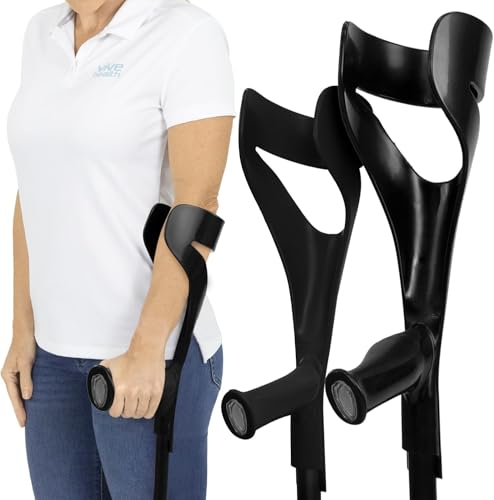
The handle is contoured for better hold and the height of the handle can be adjusted with a push-button system for increments or decrements of one inch. The handle height can be changed from 31 – 40 inches from the floor. The handle and the arm cuff have a monolithic design for better stability; however, this means that you cannot adjust the length of the forearm support and customize it as per your arm length.
The cuff has a large opening for the forearm with holes on the ears on either side of the cuff. If you anticipate situations where you must leave the handle but want the crutch to stay on your arm, you can place an elastic band through the holes to secure the crutch to your arm. It will take away some aesthetics from your crutches but will pay you back with convenience.
The handles have reflectors on the front for better visibility in low-light surroundings. The crutches have rubberized tips for noiseless use and better stability on wet and slippery surfaces.
Pros
- Made for durability with lightweight aluminum
- Easy push-button adjustability within a range of 9 inches from handle height of 31 – 40 inches for better customization as per your height
- Handle with contoured grips for better hold and reduce fatigue
- Rubberized tips for better grip on the ground
Cons
- No padding on the handle may require you to wear padded gloves for longer use
- Length of arm support cannot be adjusted
You may also like Do You Need Crutches With a Walking Boot?
#7 – Drive Medical Bariatric Forearm Crutch
The Drive Medical Forearm Bariatric Crutch has ergonomically contoured arm cuffs that are molded for stability and comfort. The vinyl handgrips are durable and comfortable and extra-large tips provide added stability.

The crutches weigh 4.86 pounds, and the leg and forearm sections are able to be adjusted independently without tools. It can support up to a weight capacity of 500 pounds and a user height in the range of 5 feet to 6’2″.
Pros
- Suitable for heavy users up to 300 pounds.
- Comfortable handgrips and stable extra-large tips.
Cons
- The arm cuffs come only in one size.
#8 – In-Motion Foldable Ergonomic Crutches
The In-Motion Pro Crutches are spring-assisted arm crutches with a technology that absorbs the impact of walking and uses the energy to assist in patient movement. This spring assist technology makes the springs quieter than the standard crutch springs. The foam rubber padding assists in reducing friction and diverts pressure from your underarms.

These are durable folding portable crutches. The re-designed cylinder bracket and double reinforces strut ensure the durability and strength of these crutches. These heavy-duty crutches can accommodate a weight capacity of up to 500 pounds.
The foot articulating tips will help in giving stability on unstable roads and surfaces. These crutches work well on indoor surfaces such as carpets or hardwood floors. They are also great on outdoor surfaces like gravel, grass, and dirt. The crutch tips provide you with additional maneuverability.
The wrists and hands are placed in a natural position with the help of the right positioning and design of these handgrips. This will prevent and eliminate nerve damage and wrist pain. The folding feature is unique and allows you to quickly circulate the crutches in and out of use without modifying any height adjustments. This makes this crutch one of the most convenient and comfortable crutches to travel with.
Generally, walking naturally in a more erect fashion is a big challenge for most conventional crutch users. The adjustable ergonomic design of these crutches allows just that in addition to the added comfort on your wrists and shoulders. This is a contributing factor to a proper and speedy recovery.
Pros
- The crutches come with a design that comfortably fits the hand in a natural way and will prevent damage to nerves and pain in the wrists.
- Easily foldable for convenient storage and easy-to-carry for transportation.
- The heavy-duty construction has a user weight capacity of 500 pounds.
Cons
- A bit expensive compared to other crutches.
#9 – Ortonyx Ergonomic Forearm Crutches
These forearm crutches from Ortonyx are made of high-density aluminum that makes them durable and lightweight at the same time. Each crutch weighs around 1.15 lbs (0.5 kg) and is easily one of the lightest crutches out there.

The handle and the arm cuffs are made of polypropylene elastomer that gives the feeling of firm padding for a comfortable grip. The device comes in 4 vibrant colors – blue, orange, purple, and ocean. The height of the crutch can be adjusted from handle downwards in the range of 30 – 39 inches (from handle to floor) and there is a secure clip system to lock into a particular crutch height. The height adjustment option is available at one-inch increments which may not give you the perfect height. If your perfect crutch height lies somewhere in between, you should get a hole drilled midway between 2 existing options.
The device is noiseless as the crutch features a rubber tip that prevents the crutch from slipping on wet or glossy surfaces. The opening of the arm cuff is large in this device and cannot be adjusted as per your forearm size. This means that the crutch will not hang from your forearm if you leave the handle to complete some other work. Also, the length of the crutch from the handle to the arm cuff is also not adjustable.
At less than 50 dollars for a pair of two crutches, this product is one of the best choices for long-term use and can be used to support individuals weighing up to 308 lbs or about 140 kgs.
Pros
- Ergonomically designed handle makes it easier to hold the crutch for long use
- Rubberized tips for noiseless use and more stability
- Lightweight and sturdy
- Adjustable crutch height within a range of 9 inches
Cons
- The length from handle to arm cuff cannot be extended for a customizable fit for your arm
- Arm cuff does not close, so you cannot leave the handle to attend to something else
You may also like Best Cane for Balance Problems
#10 – Ortonyx Forearm Crutches with Pivoting Closed Cuff
These forearm crutches from Ortonyx are made of lightweight aluminum with each crutch weighing a little over 1.1 lbs, but offer durability at the same time and can support weights up to 330 pounds.

The forearm support length can also be adjusted between 8.5 – 11.5 inches (at increments of 0.75 inches) to match the varying arm sizes of users. The closed-style arm cuffs have hinges on which they can pivot, and the user has the option of using the crutch without the cuff. However, the cuff diameters cannot be adjusted and may not fit the user closely, which could potentially lead to the crutches slipping down if you release the handles to attend to some other work.
The height of the crutch from handle to floor can be adjusted easily across a range of 30 – 40 inches. However, there are only two holes for these two height options, and you cannot adjust in between to perfectly match your height. A workaround that you may want to consider for this is to measure the height that you need and get an extra hole drilled on the aluminum tubing.
Pros
- Multi-adjustability of the crutch height, length of the forearm support, and the option to use with or without the arm cuff offer ample customization to the user
- Lightweight but sturdy device
- Rubberized tips for noiseless use and prevents slipping on wet surfaces
- Good value for money
Cons
- No padding on the crutch handle may make it uncomfortable during long use
- Cuff diameter cannot be adjusted and may not fit you closely
- No reflector lights to make the device visible in low light conditions
#11 – Ergobaum Black Mamba Forearm Crutches
The Ergobaum Black Mamba is built of light carbon fiber and is designed to be one of the most comfortable and advanced forearm crutches available. These crutches were built with usability and comfort in mind and feature an integrated shock absorption system with fully adjustable ergonomics. It also comes with knee rest steps and an alert horn. The handles and padded arm cuffs both are adjustable. There are night reflectors and also an embedded LED flashlight with easy accessibility making it easy for you to move around in the dark.
No products found.The crutches are made to reduce the amount of friction and pain experienced by the user because of its patented all-terrain Ergocap High-Performance tip, and the patented shock absorber in the lower portion of the crutch. They are made with a unique handle design that is both strong and cushiony. This allows for a comfortable grip putting in a lesser stress on your hand and the upper body. These crutches are this equipped to help you in the recuperative process and accelerated patient recovery.
The crutches are lightweight weighing only 2.6 pounds and can accommodate a user weight capacity of 350 pounds. They can be conveniently used by individuals in the height range of 5 feet to 6’6″. All materials used for the construction of this crutch are latex-free.
Pros
- Additional included accessories like LED flashlights and night reflectors are good to have for additional convenience.
- Features like adjustable cuffs and a knee rest device to provide additional comfort.
- Made of latex-free materials.
Cons
- Not suitable for people shorter than 5 feet.
- A bit expensive compared to standard crutches.
No products found.
#12 – Drive Medical Bariatric Heavy Duty Crutches
The Drive Medical Bariatric Heavy Duty Crutches provide added comfort, safety, and durability. Each of these crutches is built with steel to ensure additional strength is available on weight-bearing areas. They have a contoured underarm design and vinyl contoured tips that are non-skid and jumbo-sized.

It includes extra-thick underarm pads that are latex-free, making it easier for those having latex allergies. These underarm pads combined with the handgrips provide you with maximum comfort when in use. The push-button adjustment is tool-free and allows you to easily adjust the height of the underarm pad in increments of 1 inch. The handgrips adjust separately without tools thereby ensuring a proper fit. They offer easy wing nut adjustments.
The Drive Medical Bariatric Crutches are height adjustable and can easily accommodate a weight capacity of 500 pounds. The crutches weigh a total of 10.8 pounds and can be easily used for user height of 5’2″ to 5’10”.
Pros
- The crutches accommodate a weight capacity of 500 pounds.
- The crutch tips are jumbo-sized and non-skid.
Cons
- The crutches are a bit heavy to carry around as they are made to support higher weights. However, the weight is less noticeable when in use.
You may also like Best Canes With Seat for Obese
#13 – Sports Swings Underarm Crutch
The Sports Swings comes with large dual springs in the feet that are able to absorb most of the impact of walking, thereby increasing comfort under your armpits and hands. The shock-absorbing foot also articulates for staying on the ground much longer than the standard crutches available in the market.

The patented foot-like base provides unprecedented traction on virtually any kind of surface.
It also comes with a free swing link with every order. The removable strap will connect the crutches temporarily. This will help in preventing falls because of forwarding slipping. It prevents the all-weather crutches from slipping forward and thus avoids a fall. The swing link adds a margin of stability and safety. This may assist in faster healing and getting off the crutches quicker than usual. The Swing Link helps in setting up a safer, pre-determined stride that can be easily adjusted to accommodate your body’s healing process more dynamically.
The Sports Swings are ready to go out of the box. They feature a highly functional lightweight technology with comfy grips as well as dual springs for easy walking. The articulating foot with the patented Swing Link Safety Tether System can dramatically improve the confidence and safety of its user.
The Sports Swings come in three sizes catering to a height range of 4’6″ to 6’9″. Each Sports Swing is independently rated to accommodate a weight capacity of 300 pounds. They are designed to be used in all kinds of weather. They are a good option for not just short-term but even long-term usage.
Pros
- The Swing Link patented safety tether system reduces the risk of tripping, falling, or sideways slip-outs.
- The foot-like base provides traction on all kinds of surfaces.
Cons
- Not suitable for people weighing more than 300 pounds.
- A bit expensive compared to the standard crutches.
#14 – In-Motion Forearm Crutches
The In-Motion Forearm Crutches by Millennial Medical uses the patented Spring Assist technology inside the aluminum tubing to absorb shock coming from the ground upwards and reduces stress in the musculoskeletal structure of the upper body, forearm and wrists.

The cuffs are large in size and the diameter is not adjustable. Note that if you have smaller arms, they will not fit your arms closely. If this bothers you, you may want to clamp in the cuffs tighter by putting a high-tension elastic band around them which will make the diameter of the cuffs smaller. The distance between the handle and the cuffs can be adjusted to match your arm length.
The handles have an ergonomic design for better hold; however, they do not have padding which would have made them comfortable for long periods of use. The crutches are made of durable aluminum, weigh around 2 lbs each, and can support a maximum user weight of 350 lbs. The crutches are equipped with anti-skid tips that make them safer to use on wet and slippery surfaces. The Millenial crutch comes in two sizes of adult and youth and can be used by individuals ranging in height from 4’9†to 6’3â€.
Pros
- The spring system reduces the effort that you need to put in to propel yourself forward; especially useful for heavy users who may have a disproportionately lesser upper body strength
- Easily adjustable crutch height
- Durable and sturdy; Suitable for bariatric users
- Available in 2 sizes and 3 colors and fits most users
Cons
- Cuff diameter is not adjustable and will not fit smaller arms
- Some users have had problems with the handle and the grip which have not lasted for long
#15 – XRX Aluminum Forearm Crutches
The XRX Folding Aluminum Walking Forearm Crutches provide a secure and comfortable experience. They eliminate pain and fatigue caused by traditional crutches while allowing you the mobility that you would need while managing a disability or recovering from a surgery or leg injury.
No products found.They have an ergonomic supportive grip that is contoured to fit your hand. This reduces the fatigue in your hands and the wrist, thereby ensuring proper positioning for safe movement throughout your daily activities.
It can instantly adjust to a convenient height ranging from 33 inches to 45.7 inches. This can be done with just the push of a button. There are 10 convenient heights to which this can be adjusted.
The rod is made of aluminum alloy and each cane is very light in weight (close to 1.1 pounds). The maximum load-bearing capacity is 220 pounds. The foot of the crutches is capped with a honeycomb rubber to bring in additional stability. The single-foot design helps it to easily fit on the stairs or in a narrow passageway. The rubber base is non-skid and durable providing greater traction and control when you are walking on loose or uneven terrain, including gravel, grass, and sand.
Pros
- Lightweight and foldable.
- Stable and durable on uneven terrain including grass, gravel, and dirt.
Cons
- The weight-bearing capacity is only up to 220 pounds and is thus not suitable for people on the heavy side.
No products found.
You may also like Best Upright Walkers for Seniors
Parting Words – Keep Your Friends Close and Your Crutches Closer
Although our top choice in this list is the Ergobaum 7G Ergonomic Forearm Crutch, evaluate your choices based on your uniques circumstances. We advise that you consult your doctor before making a final decision on a pair of crutches.
A good crutch is a game-changer for somebody who is looking to increase mobility after a foot or leg injury. Although slightly expensive, forearm crutches have been gaining in popularity. If you have been using a traditional crutch, you will immediately notice some of the benefits and over the long term will also feel less strain on your upper body. All in all, unless you prefer a wheelchair or you have injured both legs, the forearm crutch may just be your best bet.
The crutch that you decide to purchase would depend on multiple factors. However, cost and quality are two key considerations for anyone. But when it comes to durable medical equipment, it is better to err on the side of better quality. After all, one slip and fall can cost much more than the few dollars that one will save by compromising on quality.
Crutches are a great mobility device if you are recovering from foot surgery. But if you need greater assistance or the help of a caregiver to move about, a transport wheelchair can be a good option for you. These wheelchairs are lightweight and ideal for movement within a building. However, they do require a caregiver to push them.
A rollator walker is a good choice for those who can put weight on both legs but need some support while walking. These devices also come with a seat, allowing you to rest if you are tired after walking.
All the devices that we have talked about so far, are self-powered. That limits the range that you can travel with them.
If you are looking to cover a longer distance with your mobility device or if you are the outdoors type, you need to go the electric route. You can choose from power wheelchairs, mobility scooters, or electric tricycles. All these devices are powered and serve different mobility needs.
References

